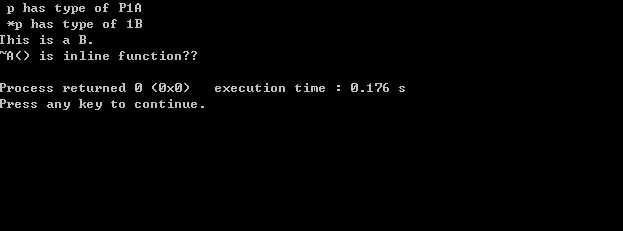C++的学习总是一个漫长的过程。前一篇是关于输入、输出流同步的问题,今天又谈到虚函数,给人一种无序的杂乱感。先不管了,记录下来,好记性不如烂笔头。
一、什么是虚函数
在某基类中声明为 virtual 并在一个或多个派生类中被重新定 义的成员函数,用法格式为:virtual 函数返回类型 函数名(参数表) {函数体};实现多态性,通过指向派生类的基类指针或引用,访问派生类中同名覆盖成员函数。
这是百度百科的定义,简单明了,我们下面通过实际例子来感受下。
1,程序a.cpp。我们定义类A,并派生出B,B类重载了A中的foo().主函数中,A *p = new B; p->foo();观察程序输出,判断调用了A还是B的foo().

1 #include <iostream> 2 #include <typeinfo> 3 using namespace std; 4 5 class A { 6 public: 7 A(){}; 8 ~A(){}; 9 void foo() { 10 cout << "This is an A." << endl; 11 } 12 }; 13 14 class B : public A 15 { 16 public: 17 B(){}; 18 ~B(){}; 19 void foo() { 20 cout << "This is a B." << endl; 21 } 22 23 }; 24 25 int main() { 26 A *p = new B; 27 28 cout << " p has type of " << typeid(p).name()<<endl; 29 cout << " *p has type of " << typeid(*p).name()<<endl; 30 p->foo(); 31 delete p; 32 return 0; 33 }

从输出我们可以看到,p->foo()调用的是A的foo().另外,我们还可以通过typeid(p).name()来查询p的类型。typeid方法定义在<typeinfo>中,可以查看源码,里面定义了 class type_info, 这里不在多讲。
2,程序b.cpp。这里,我们更改a.cpp中A,BD的foo()为虚函数。再看看输出效果如何
先提前注意下,当声明A中的foo()为虚函数时,其析构函数也要声明为虚函数,否则会产生一下warning: deleting object of polymorphic class type 'A' which has non-virtual destructor might cause undefined behavior [-Wdelete-non-virtual-dtor]|
编译器为GCC 6.1.0,此warning的深层机制没有深究,还请广大博友赐教了。好,看程序。

1 #include <iostream> 2 #include <typeinfo> 3 using namespace std; 4 5 class A { 6 public: 7 A(){}; 8 virtual ~A(){}; 9 virtual void foo() { 10 cout << "This is an A." << endl; 11 } 12 }; 13 14 class B : public A 15 { 16 public: 17 B(){}; 18 ~B(){}; 19 virtual void foo() { 20 cout << "This is a B." << endl; 21 } 22 23 }; 24 25 int main() { 26 A *p = new B; 27 28 cout << " p has type of " << typeid(p).name()<<endl; 29 cout << " *p has type of " << typeid(*p).name()<<endl; 30 p->foo(); 31 delete p; 32 return 0; 33 }
注意看输出,

我们看到,p还是A类型的指针,但是*p却是class B类型。然后p->foo()调用的是B的foo().这就是RTTI机制(Runing Type Information),它提供了运行时确定对象类型的方法。
总结下,当基类指针指向一个子类对象,通过这个指针调用子类和基类同名成员函数的时候,基类声明为虚函数(子类同名函数不是虚函数也可以)就会调用子类的这个函数,不声明就会调用基类的。
这里,引入一个问题,如果我们把析构函数写成如下形式:
virtual ~A(){ cout << "~A() is inline function??" << endl; };
请问,~A()是内联函数吗?因为我们都知道,类中定义的函数默认为inline函数,那这里的~A()呢??
虚函数与内联函数的联系,见下文三、虚函数可不可以是内联函数。
二、虚函数的用处
大家都知道league of legends吧,假如我们所有的英雄都是基于父类Legeng的,有个纯虚函数q_attack() = 0;然后它派生出的子类,如FrostArcher,ProdigalExplorer,LooseCannon都实现了自己独特的q攻击函数q_attack()。当他们三个开团时,他们不停的用自己的攻击方式去攻击敌人(好怪异,开团只用q)。这个时候,我们就可以定义一个父类指针数组legend,把这三个英雄的指针封装起来,然后循环的legend[i]->q_attack(), 三个legend就不停的攻击敌人了。
示意代码如下:
1 int main() { 2 Legend *legend[3]; 3 legend[0] = new FrostArcher; 4 legend[1] = new ProdigaExplorer; 5 legeng[2] = new LooseCannon; 6 7 for (int i = 0; i < 3; ++i) { 8 legend[i]->q_attack(); 9 } 10 11 return 0; 12 }
三、虚函数可不可以是内联函数
内联函数是指用inline关键字修饰的函数。在类定义中的函数被默认为内联函数。
内联函数从源代码层看,有函数的结构,而在编译后,却不具备函数的性质。内联函数不是在调用时发生控制转移,而是在编译时将函数体嵌入在每一个调用处。编译时,类似宏替换,使用函数体替换调用处的函数名。一般在代码中用inline修饰,但是能否形成内联函数,需要看编译器对该函数定义的具体处理。
上述定义来自百度百科,感觉还是比较清晰的。
1,程序c.cpp。我们在b.cpp的基础上,为foo()方法添加inline关键字,观察程序输出。

1 #include <iostream> 2 #include <typeinfo> 3 using namespace std; 4 5 class A { 6 public: 7 A(){}; 8 virtual ~A(){ 9 cout << "~A() is inline function??" << endl; 10 }; 11 inline virtual void foo() { 12 cout << "This is an A." << endl; 13 } 14 }; 15 16 class B : public A 17 { 18 public: 19 B(){}; 20 ~B(){}; 21 inline void foo() { 22 cout << "This is a B." << endl; 23 } 24 25 }; 26 27 int main() { 28 A *p = new B; 29 30 cout << " p has type of " << typeid(p).name()<<endl; 31 cout << " *p has type of " << typeid(*p).name()<<endl; 32 p->foo(); 33 delete p; 34 return 0; 35 }
输出如下,

我们看到,与b.cpp相比,程序输出一模一样。说明,即使虚函数声明为inline,仍然实现动态绑定。
所以,结论是虚函数不可能是内联函数。
四、简单谈谈const(与虚函数无联系,临时想到)
virtual,inline都是修饰函数的,现在突然想到const,也总结下吧。如果我们在foo()后面添加const ,有什么意义呢?那就是把foo()修饰为const,foo()函数体内不能对成员数据作任何改动。如果声明类的一个const 实例,那么它只能调用const修饰的函数。
1,程序d.cpp。我们在c.cpp的情况下,修改B的foo()为foo() const, 并添加非cosnt函数foo2(). 当 const B cb;我们观察下cb.foo(), 和 cb.foo2()哪个会执行?

1 #include <iostream> 2 #include <typeinfo> 3 using namespace std; 4 5 class A { 6 public: 7 A(){}; 8 virtual ~A(){ 9 cout << "~A() is inline function??" << endl; 10 }; 11 inline virtual void foo() { 12 cout << "This is an A." << endl; 13 } 14 }; 15 16 class B : public A 17 { 18 public: 19 B(){}; 20 ~B(){}; 21 inline void foo() const{ 22 cout << "This is a B." << endl; 23 } 24 25 void foo2() { 26 cout << "foo2() is not const." <<endl; 27 } 28 29 }; 30 31 int main() { 32 A *p = new B; 33 const B cb; 34 cout << " p has type of " << typeid(p).name()<<endl; 35 cout << " *p has type of " << typeid(*p).name()<<endl; 36 p->foo(); 37 38 cb.foo(); 39 //cb.foo2();//error: passing 'const B' as 'this' argument discards qualifiers [-fpermissive]| 40 delete p; 41 return 0; 42 }
经实验,cb.foo2()会出现error,见程序注释。
总结:
* const对象只能调用const成员函数。
* const对象的值不能被修改,在const成员函数中修改const对象数据成员的值是语法错误 。
* 在const函数中调用非const成员函数是语法错误。
最后,贴出调用cb.foo()的运行结果

好了,虚函数简单写在这。另外,关于纯虚函数以及type_info的内容还有很多,可以参见http://blog.csdn.net/hackbuteer1/article/details/7558868和http://www.jb51.net/article/55968.htm,写的比较详细。
